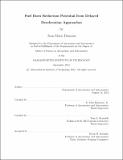| dc.contributor.advisor | R. John Hansman, Jr. and Tom G. Reynolds. | en_US |
| dc.contributor.author | Dumont, Jean-Marie, S.M. Massachusetts Institute of Technology | en_US |
| dc.contributor.other | Massachusetts Institute of Technology. Dept. of Aeronautics and Astronautics. | en_US |
| dc.date.accessioned | 2013-02-15T14:39:21Z | |
| dc.date.available | 2013-02-15T14:39:21Z | |
| dc.date.copyright | 2012 | en_US |
| dc.date.issued | 2012 | en_US |
| dc.identifier.uri | http://hdl.handle.net/1721.1/77108 | |
| dc.description | Thesis (S.M.)--Massachusetts Institute of Technology, Dept. of Aeronautics and Astronautics, 2012. | en_US |
| dc.description | Cataloged from department-submitted PDF version of thesis. This electronic version was submitted and approved by the author's academic department as part of an electronic thesis pilot project. The certified thesis is available in the Institute Archives and Special Collections. | en_US |
| dc.description | Includes bibliographical references (p. 79-80). | en_US |
| dc.description.abstract | Changing aircraft operational procedures is one strategy that can be used to reduce fuel burn and mitigate environmental impacts of aviation in relatively short timeframes with existing aircraft types. One promising modification comes from increasing the use of Delayed Deceleration Approaches where the deceleration to the standard stabilized final approach speed occurs later, which keeps the aircraft in clean aerodynamic configuration with low thrust for as long as possible. Although such approaches can reduce fuel burn, in practice aircraft often decelerate much earlier. This may be for a variety of reasons, such as airspace restrictions, slower traffic ahead, air traffic controller technique and airline procedures and/or pilot technique. In this study, operational flight data has first been used to quantify the potential fuel burn savings associated with Delayed Deceleration Approaches. Aircraft that were observed to decelerate and configure flaps later in the approach had 30-40% lower fuel burn and carbon dioxide emissions below 10,000 ft compared to those that did not. Estimates of US system-wide fuel burn and emissions reduction potential from Delayed Deceleration Approaches have also been produced. Second, radar tracks of flights to different airport areas have been analyzed to help identify reasons for early decelerations. By observing the context of evolution of the less fuel efficient flights, the role of different potential factors such as preceding traffic, traffic mix, highly constrained airspace, runway interactions and severe weather conditions affecting the airspeed schedule of a given flight have been examined. Weather appeared to be a major parameter affecting the airspeed schedule, and air traffic procedures involving early decelerations appeared to have been used in dense and complex airspaces. | en_US |
| dc.description.statementofresponsibility | by Jean-Marie Dumont. | en_US |
| dc.format.extent | 80 p. | en_US |
| dc.language.iso | eng | en_US |
| dc.publisher | Massachusetts Institute of Technology | en_US |
| dc.rights | M.I.T. theses are protected by
copyright. They may be viewed from this source for any purpose, but
reproduction or distribution in any format is prohibited without written
permission. See provided URL for inquiries about permission. | en_US |
| dc.rights.uri | http://dspace.mit.edu/handle/1721.1/7582 | en_US |
| dc.subject | Aeronautics and Astronautics. | en_US |
| dc.title | Fuel burn reduction potential from delayed deceleration approaches | en_US |
| dc.type | Thesis | en_US |
| dc.description.degree | S.M. | en_US |
| dc.contributor.department | Massachusetts Institute of Technology. Department of Aeronautics and Astronautics | |
| dc.identifier.oclc | 825066855 | en_US |
